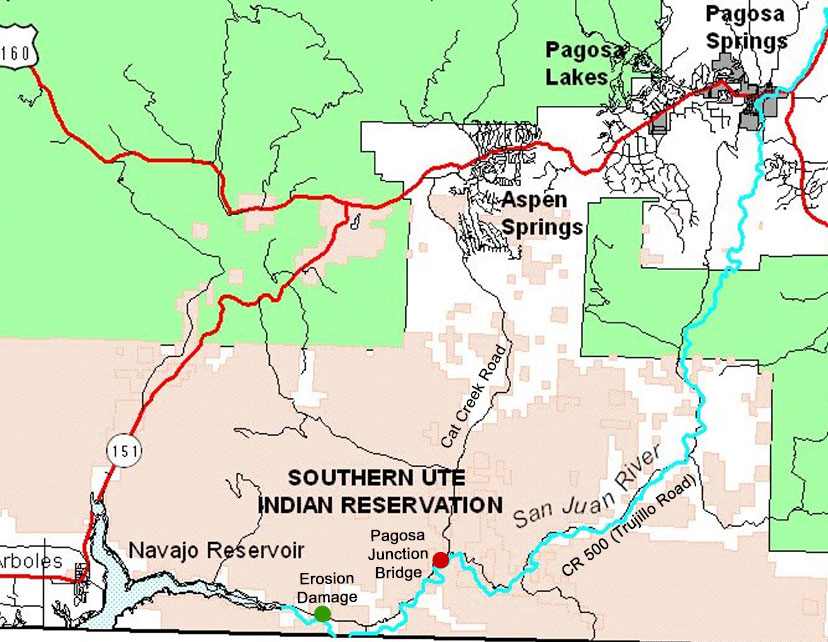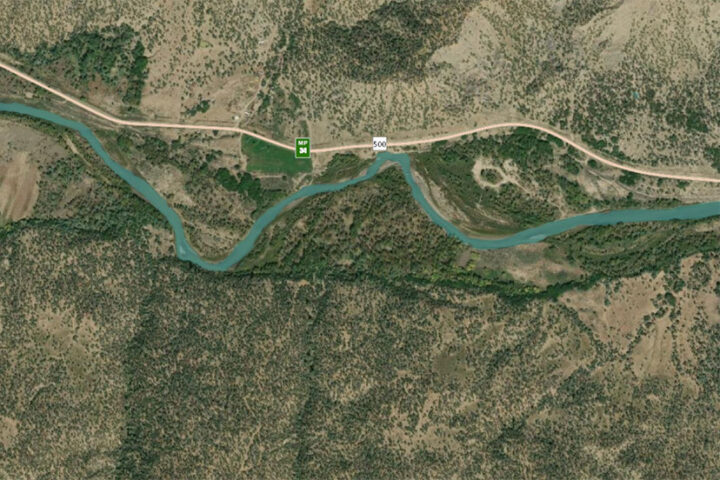I hope to get a statement from the Southern Ute Indian Tribe, explaining the steps they see as necessary to fix the two key problems on County Road 500…
…a road maintained by Archuleta County but which passes mainly through Tribal land, apparently without the benefit of a right-of-way.
The two key problems being: the failing Pagosa Junction Bridge, and the serious erosion caused by the San Juan River at Mile Marker 34.
I haven’t found any information about when CR 500 was constructed, but I assume it was some time after the construction of the Denver and Rio Grande Railroad line that connected Pagosa Junction to the town of Pagosa Springs. The Town of Pagosa Springs was first surveyed in 1883 and incorporated in 1891, well after the Ute Indians had been granted possession of what is currently the SUIT reservation. That land was originally part of the 56-million-acre reservation ceded to the various Ute tribes in 1868, comprising approximately the western one-third of Colorado. The current Southern Ute Reservation is considerably smaller, comprising about 677,000 acres.
On Wednesday, Archuleta County consultant Laura Vanoni and I drove down Highway 151 to the southern entrance of Trujillo Road (CR 500), to see and take photos of the erosion at Mile Marker 34. The green dot on the map below shows the approximate location of the threatened roadway.

As we can see on the map, there’s a mix of SUIT land (brown) and private land (white) located between the now-closed Pagosa Junction Bridge and the spot where the San Juan River is threatening CR 500. The Caracas Mesa gas well iis also located in between these two problem areas.
As we looked at the 30-foot-high cliff created by the erosion process, Ms. Vanoni noted that the cliff appears to be composed entirely of silt. Not the type of geological structure that can easily withstand the endless pounding by a river making a rather dramatic bend.

The site filled me with a sense of awe. I had heard about this erosion problem a couple of years back, but had not expected to see a 30-foot cliff.
Below is a satellite image from the County website.
The continuing erosion is taking place right about where the white “500” square is located.
Ms. Vanoni had visited this site last October, when she and the Bureau of Reclamation (BOR) were documenting the culverts that run under CR 500, and which are constantly filling with silt. (Another ongoing problem on CR 500.)
Was the BOR surprised by how the erosion was progressing?
“Well, it’s been going on for a while. It didn’t look as bad as it looks today, but it was pretty impressive. There was a gap of about five feet in the dirt and you could see, a huge chunk was getting ready to drop off into the river. But there was still another ten feet of ground that was still there, near that tree. But now it’s all gone.”
Inn the photo below, you can see the leafless tree to which she was referring, on the far edge of the cliff.
This next photo shows the original roadway, to the right of the concrete barriers, seriously threatened by the ongoing erosion.
The evergreen shrub on the far right appears ready to tumble into the river as the damage moves closer to the road.
The roadway has been relocated about 12 feet farther to the north, and barriers have been installed. How long any of this will last is anyone’s guess.
Ms. Vanoni was thoughtful as we left the site. “I mean, it is pretty amazing. But it’s also pretty scary. And you know, with all the snow melt and the powerful water that we have already in the river, that’s a huge problem, and then the second problem is the monsoon season. When that comes, and washes even more down from these hills…”
She motioned at the sandy, piñon-covered hills north of the road.
“…I mean, how do you stop it? It’s just nature. How do you stop nature?” She laughed. “You’re fighting a losing battle…”
There is, of course, another type of nature that we’re dealing with.
Human nature.
We furnish our elected leaders with considerable authority and power, to oversee, and care for, our public needs, using the public funds we provide them with.
Sometimes, our elected leaders fail to fulfill the duties we thought we handed them. The failure can be the result of financial shortages, lack of foresight, mistaken judgement, corruption, or simply acts of nature. There are obviously acts of nature that challenge our intelligence and resolve, like the natural slow deterioration of a bridge… or the erosion of a roadway.
There’s also the challenge of our competitive human nature, our cautious nature, our defensive nature, that sometimes get in the way of collaboration and cooperation.
You can feel like you’re fighting a losing battle.
Not that I, personally, feel that way.
Call me an helpless optimist. I believe we can figure out a way to move forward with the problems along County Road 500.




